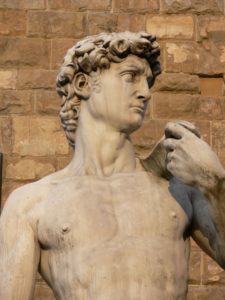Michelangelo’s four secrets to sculpting the perfect David.
Michelangelo’s sculpture of David is one of the greatest masterpieces ever created by mankind, and a highly symbolic work of the Renaissance period. David manifests poise and perfection in youthful, sinewy beauty—and its colossal size of 5.17 metres could simply take your breath away.
Italian painter Giorgio Vasari (1511-1574) said of David, “When all was finished, it cannot be denied that […] no other artwork [modern or ancient, Greek or Latin] is equal to it in any respect, with such just proportion, beauty and excellence did Michelangelo finish it.”
The marble from which David was carved from was greatly imperfect, leading to the project being abandoned several times. At the turn of the 16th century, the Cathedral of Florence commissioned a series of large sculptures from the Old Testament to be placed in the niches. Two sculptors before Michelangelo had given up on hewing David out of a huge expensive block of marble: Agostino di Duccio in 1466 and Antonio Rossellino in 1475. To make things worse, the marble slab was perforated with small cavities. The project was abandoned, and the marble was left in the cathedral backyard for 26 years. In 1501, 26 year old Michelangelo picked up this unfinished marble and won the contract over Leonardo da Vinci and other more famous sculptors.

David, Michelangelo (1501-1504) in Florence, Italy
What made Michelangelo take on this near impossible feat? How did Michelangelo come to fashion such a marvelous work of art from an imperfect raw material? What kind of mindset and qualities did Michelangelo have that made this possible? Michelangelo’s act of taking on the impossible is a befitting parallel to how each of us can uncover our unique, whole and best self—the David in us—from the bundle of imperfections that most of us so often feel. Here are Michelangelo’s four secrets.
1. Vision—See With Your Mind’s Eye
We are often asked by senior leaders and young people how to come up with a vision, for a business and their life. This is a core part of our LIFE programs. The answer lies in unlocking and tapping on our deeper energies.
To resurrect the David’s project, several artists were consulted, including Michelangelo’s rival Leonardo Da Vinci. Only Michelangelo managed to convince the Cathedral of Florence that he was capable of accomplishing a finished sculpture. Michelangelo could confidently rise to this enormous challenge, because he already had the finished work in mind. In the physical, Michelangelo faced a huge slab of unfinished marble. In the mental, Michelangelo pictured David at the apex of his concentration and tension—relaxed yet vigilant, in the classical contrapposto.
Success starts in the mind, with yourself. Are you able to see the outlines of your David in flawed situations and people? Others may not, but as long as you do, you are miles ahead of others. Such seeing requires your whole being, when your mind is connected with your heart and spirit, integrated and channeled to tackling outer challenges and opportunities. To reach this state, you need to master your fears and anxieties, such as being accepted by others.
2. Unconditional Acceptance—Work With Who Is Inside Of Yourself
Your unique, whole and best self is already in you; you just need to uncover it and learn to let your true self show up in critical comments. To do this, you need to see, accept and master yourself. You need to reign in certain aspects, while accentuating and letting rip others.
The marble that Michelangelo worked with was severely flawed. Yet he focused on revealing his vision of David from inside the marble slab, by removing what was unnecessary. He learned to see beyond the flaws. In fact, everything and everyone is imperfect in some way. Greatness comes from building on the uniqueness of what you see in a situation and a person.
There is a unique, whole and best self inside everyone that is waiting to be revealed through your own and others’ carving. The carving comes in several forms—becoming aware of yourself; rising up to challenges, especially in the darkest hour; mastering your urges and instincts in the process. Less effective leaders often overuse certain instincts and strengths, which results in other talents being underutilized. Learning to rein in overdeveloped aspects and activate hidden strengths puts you on the path to honing the true great leader in you.
3. Conviction—Ignore The Naysayers
Michelangelo encountered enormous opposition to his vision of David. Individuals charting their own path, and leaders doing truly transformative and high-impact work should expect the same thing. In the face of opposition, you need courage and conviction to persist.
Michelangelo went against the convention of depicting a triumphant David over a slain Goliath. Instead, he pictured a pensive David right before the battle with the slingshot over his shoulders. Few of his contemporaries were supportive of David. Because of this, Michelangelo worked on the statue in utmost secrecy and seclusion. He fiercely protected his work in the making and did not reveal it to anyone until 1504. He stayed true to his vision and did not change it.
It is natural for people to judge, sometimes harshly, out of their own experiences, motivations and accepted norms. A great leader must persist on the path of uncovering the David inside of oneself and their company.
4. Persistence—Chisel Away Continuously And Systematically
Uncovering the David in yourself is life-long process. It requires high commitment and patience to climb high mountains of opportunity and get through painful valleys of tribulation. Michelangelo worked continuously on David over two years out in the open courtyard—in the rain and the sun, sleeping sporadically without changing out of his work attire and rarely eating.
Becoming the best you can be requires a lot of consistent work on your part. In our LIFE programs, we work with leaders as young as 18 years old and as old as 60 years old, and we see that the unique, whole and best self is gradually revealed in the process of tackling opportunities and challenges in work and life. You need to learn from those experiences through deep reflection, high challenge and high support from others. It takes great care to figure out which parts need the greatest attention and not to carve out the wrong parts. The great reward is finally revealing the beautiful David in you, instead of merely being a shadow or a distorted you. Are you willing to chisel yourself against life even though it could be painful?
The biggest fallacy of leadership development is emphasizing the learning of skills and concepts. It is a big reason why so much of leadership development fails to achieve any real impact. The leader is already in you. Everyone has a David in them. The essence of leadership development stems from personal development—to uncover the leader and your unique, whole and best self. When you see and start to work on the David in you, others will eventually see the David in you too. When you see the David in others and help them uncover it, it helps you see the David in yourself more easily too. High challenge and high support is another core of our philosophy, and will be covered in a future article.
LinHart has a deep heritage of CEO counselling, board advisory and executive mentorship. We have specially designed a high level and high impact leadership influence accelerant program for early executives, LIFE2. Get in touch with our Principal, Huijin Kong (huijin@linhartgrp.com) to find out how LIFE2 program can be a good fit for you.
Published in April 2019
